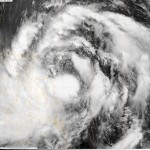Typhoon Aere pounds and drenches the Philippines
Typhoon Aere slammed into the central and eastern part of the Philippines, including the capital Manila, bringing with it heavy rains and causing severe flooding. Thousands of passengers were stranded because of the suspension of ferry services between islands in the Pacific archipelago.
Packing winds of 53 miles per hour (or 85 kilometers per hour), the typhoon made landfall in the eastern island of Catanduanes and was expected to move northwest to the main island of Luzon in the next 48 hours, the local weather bureau Philippine Atmospheric, Geophysical & Astronomical Services Administration said late afternoon yesterday.
Civil authorities have reported nine deaths so far, including three in Camarines Sur province, related to the onslaught of Typhoon Aere. In the capital Manila, west of Catanduanes island, 18-inch-deep floods lasting two hours hit the city's streets. The floods were exacerbated by overflowing creeks and drainage systems which are clogged with garbage - a perennial problem of city authorities.
Almost 2 years ago ago, Typhoon Ketsana battered the Philippines and caused massive flooding. The force of nature claimed 400 lives and affected 5 million people.
Now, Typhoon Aere is bringing the same type of devastation albeit on a smaller scale. According to the National Disaster Risk Reduction & Management Council, about 5,000 families have been evacuated from hard-hit areas and 4,000 are believed to be stranded in seaports.
People along the coast and river banks were advised to seek temporary shelter on higher grounds to prevent any loss of life from storm surges.
The Philippines is at the center of the so-called typhoon belt where strong storms claim lives and damage property every year. Typhoon Aere heralds this year's typhoon season.
